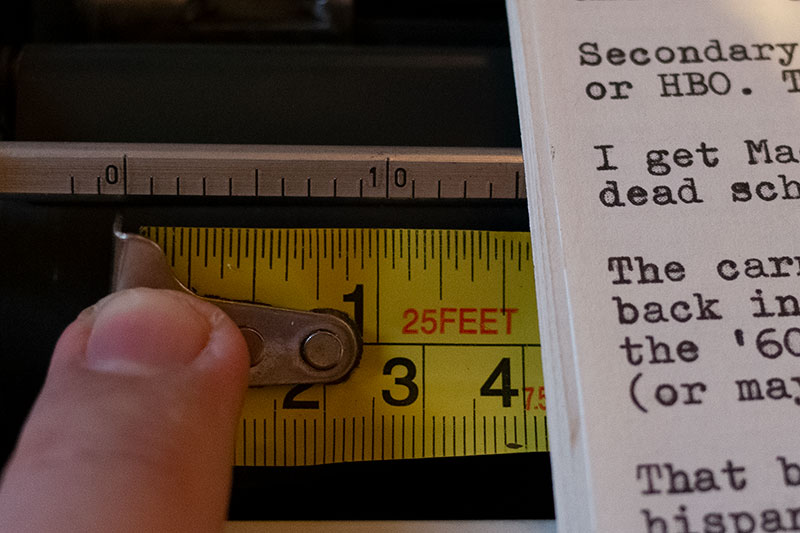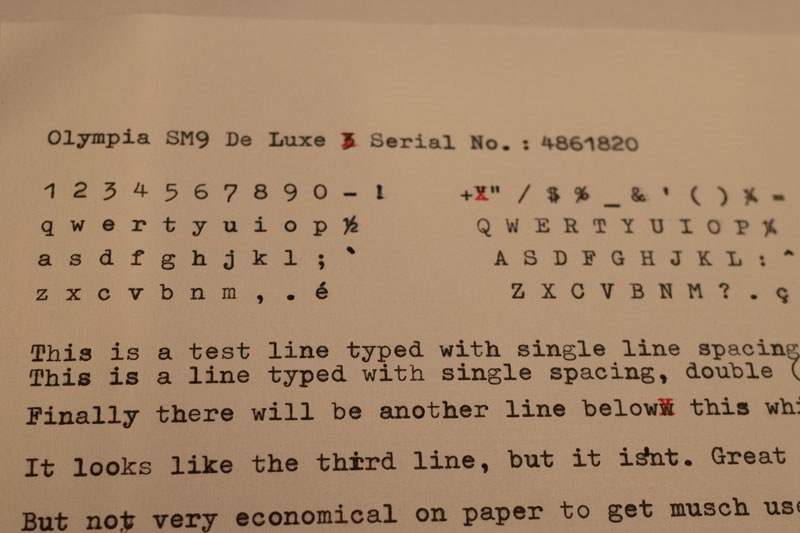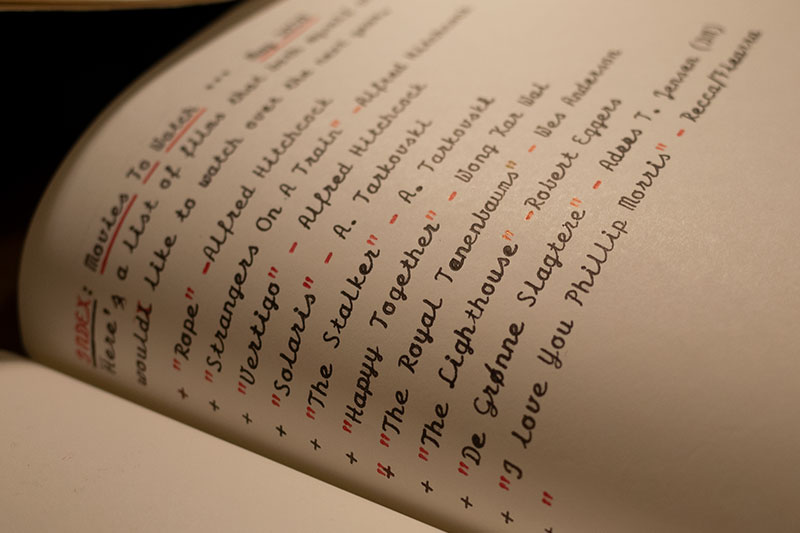- Jaype
- New Member
 Offline
Offline - Registered: 20-4-2020
- Posts: 3
Re: New Member Thread
M. Höhne wrote:
Welcome, Jaype. With your SM9 of uncertain pitch, just hold a ruler up to the paper bail and count how many tic marks there are in one inch---that's the pitch, and I'll bet it's 11 cpi, which is what all my SMs are. I don't know if that's a European standard nor what they call it, but it's not the English elite (12 cpi) nor pica (10 cpi).
If someone can enlighten me about the common European pitch(es) and their name(s), I will appreciate it.
Thanks :-) I've taken a quick pic, but it seems to be dead on 10. So that would make this Pica No.12 (according to the images on Munk.org). Feel free to correct me if I'm looking at it wrong though.
I've found that the ribbons I have all need the eyelets chopped off. If I do leave them on, they just end up getting chewed up in the vibrator mechanism before the reversal clicks in.
- M. Höhne
- Key Master
 Offline
Offline - From: Maine
- Registered: 14-3-2013
- Posts: 646
Re: New Member Thread
Yep, that sure looks closer to 10 than 11. A tip about measuring that I learned in school (yes, they're good for something) is to not go from the very end of the ruler (because it's often worn or might be a little off because of manufacturing, or in your case here, has a moveable hook that makes it hard to decide on a base point. Instead, measure between two clearly marked points, like the 1 line to the 2 line or if it's easier to handle the tape, between, for example, the 8 line and the 9 line.
I agree yours looks a lot like Pica No. 12 but not merely because it's 10 cpi. A font (a particular design like roman, italic, bold, within a typeface) usually has to be pinned down by comparing several different glyphs (characters), some of the most common distinctive ones being: G, g, M, Q, 4, &, K, k, 3, etc. Your sample doesn't show most of those but it still matches better with Pica No, 12 than with any of the other 10 cpi fonts in Munk's samples.
About the eyelets, I came across this (sorry, no citation but it, uh, it does make sense): “Can I just say, having been in the typewriter trade since 1975, PLEASE take it from me that the Group 1 (or Group 1001) ribbon intended for Olympia, Adler, Facit and many other makes DOES NOT have eyelets !! The ribbon mechanism is designed to trip and reverse when the ribbon gets taut as one spool becomes full and the other totally empty. Someone may well have fitted an eyeletted ribbon to a Group 1 spool as a bodge to get over a sluggish or badly adjusted ribbon reverse mechanism - to give the reversing fork an extra 'nudge'. The factory did not intend the ribbon to be reversed this way.”
HTH
- Jaype
- New Member
 Offline
Offline - Registered: 20-4-2020
- Posts: 3
Re: New Member Thread
Many thanks again for the info. HTH. Access to picking people's brains who've been working with typewriters for that chunk of time is certainly why I'm here. I don't feel bad about chopping off those eyelets.
Just to be silly I'll put some more pics in here. I have too much time on my hands clearly.
Here's a sample of the whole set of glyphs. I studied typography at London College of Printing oddly enough, but that was over 15 years ago (time really does fly). We used to play around with typesetting on various ancient printing machines - but we never played with typewriters much and I never did end up going into graphic design (which was the intention of at the time).
The character set shows the French Canadian keyboard. So it has the $, but no £. Along with the é and ç etc. The serial # seems to place it around 1975.
I'm taking some shots of them to upload onto the TWDB - but realise I have to get my account confirmed etc.
The script font I have on the other machine is pretty... but again, not certain of the cpi. Will try measuring between 2 and 3 next time ;-)
I'm mainly using it for journaling (and letters) at the moment - the serial on it is #4758198, so I think a 1974 model.
- thetypewriterman
- Key Master
 Offline
Offline - From: Leiston, England
- Registered: 29-5-2013
- Posts: 941
Re: New Member Thread
The 11 pitch option is called 'Continental Elite' in the UK. It always appears on portables, never on office typewriters. You tend to find it on German-made machines, although Hermes of Switzerland used it, and also some Japanese makers (copying the Germans, no doubt !) It is a compromise typeface of course. Larger than Elite and smaller than Pica. Regarding the eyelets on Group 1 (1001) ribbons, I couldn't have put it better myself. However, the strangest thing is that Olympia, and I think Adler too, equipped their American-market machines with ribbon mechanisms intended to take Group 9 (same as Brother) ribbons, presumably because these were more readily available in the States than Group 1. The Group 9, does have eyelets !
- bcarter
- Novice Typer
 Offline
Offline - Registered: 10-4-2022
- Posts: 26
Re: New Member Thread
I have very little expertise but I think the font is Olympia #69 Script. The uppercase E does not descend as it and the uppercase C do on their #75 Script font.
- OregonJim
- Touch Typist
 Offline
Offline 
- From: Oregon, USA
- Registered: 06-11-2022
- Posts: 161
Re: New Member Thread
Hello fellow typers!
I'm Jim from Oregon (USA), though I was born and raised in New England. Have been lurking for awhile. I have a modest collection: 1948 Royal Quiet DeLuxe, a couple of Smith-Corona Classic 12's, an Electra 120, Coronet, and Corsair Deluxe; a couple of IBM Selectric II's, a Montgomery Ward Signature 100, a Brother EP-41 Travel-Riter, and a few assorted daisy-wheel electronic typewriters.
No doubt I will be adding to the collection, but right now, the only machine I'd really like to get is a Royal KHM. My grandmother had one when I was a child - she let me use it to type my first family "newspaper" when I was about 10. That would have been around 1971. I still have a copy!
My high school typewriter was a Smith-Corona Classic 12 - I now have two of them - one in pica, the other elite.
I'm also a fountain pen enthusiast, along with pretty much anything stationery related. I'm compiling a book of poetry, and another of short stories. I don't know if I'll ever get around to writing a novel - that endeavor doesn't seem to be calling me (yet).
Anyway, enough about me. Hello!
- fountainpensplus
- Touch Typist
 Offline
Offline - From: Eugene, OR, USA
- Registered: 11-10-2021
- Posts: 153
Re: New Member Thread
Hello Jim and welcome from another in Oregon and fellow stationery aficionado!
George
- ravvale1
- New Member
 Offline
Offline - Registered: 07-1-2023
- Posts: 3
Re: New Member Thread
Hi there. My name is Steve. I started this obsession/passion with a Hermes 2000 back in 2019, which I bought on eBay from a writing teacher by the name of Dean, who had written an essay on his eBay sellers page, explaining that while the computer and its great software might be the best *word* processing tool, the typewriter is the best *thought processing* tool.
I was struck by that idea, bought that machine (partially wanted a typewriter to write Quintin Tarantino a thank you letter for Once Upon A Time In Hollywood, and felt a typewriter was the best way to do that), and found that a) it’s true. And b) I have fallen in love with the typewriter as my best bet to write everyday.
So, in short; while I do have a small collection now (my current favorite and my main everyday writing tool being my Underwood TouchMaster Five aka “The Tank”), my main interest is using these brilliant machines for writing.
Great and grateful to be here.
Thank you for adding me.
- fountainpensplus
- Touch Typist
 Offline
Offline - From: Eugene, OR, USA
- Registered: 11-10-2021
- Posts: 153
Re: New Member Thread
ravvale1 wrote:
Hi there. My name is Steve. I started this obsession/passion with a Hermes 2000 back in 2019, which I bought on eBay from a writing teacher by the name of Dean, who had written an essay on his eBay sellers page, explaining that while the computer and its great software might be the best *word* processing tool, the typewriter is the best *thought processing* tool.
I was struck by that idea, bought that machine (partially wanted a typewriter to write Quintin Tarantino a thank you letter for Once Upon A Time In Hollywood, and felt a typewriter was the best way to do that), and found that a) it’s true. And b) I have fallen in love with the typewriter as my best bet to write everyday.
So, in short; while I do have a small collection now (my current favorite and my main everyday writing tool being my Underwood TouchMaster Five aka “The Tank”), my main interest is using these brilliant machines for writing.
Great and grateful to be here.
Thank you for adding me.
Hello Steve and thank you for expressing your joy of typing. For me it was writing by hand becoming arthritically challenging. A neighbor reminding me that I once loved to type and then looking around I found this forum.
The first manual machine I roll over to my desk is also a standard; Olympia SG1. Thankfully I managed to find three great, rolling metal typing tables. At just under 40 pounds there is nothing 'portable' about it. The solid mass of the standards makes them the best to type on in my opinion.
George
- ravvale1
- New Member
 Offline
Offline - Registered: 07-1-2023
- Posts: 3
Re: New Member Thread
Hey George. Totally agree with everything you said. While I don’t yet have an arthritic challenge with writing with a pen, I have always had both a legibility problem and at least discomfort, if not pain writing that way. The computer was a kind of liberation, in that now, I could write, communicate and get through 10 years of rabbinical seminary, and years as a chaplain in the USAF.
But it still felt like a lacuna to me. It wasn’t me physically writing. And when I did, even I can’t read it sometimes. Never have that problem with a typewriter, no matter how many typos. As the title of a book about the beatniks says “The Typewriter Is Holy”! Amen!


